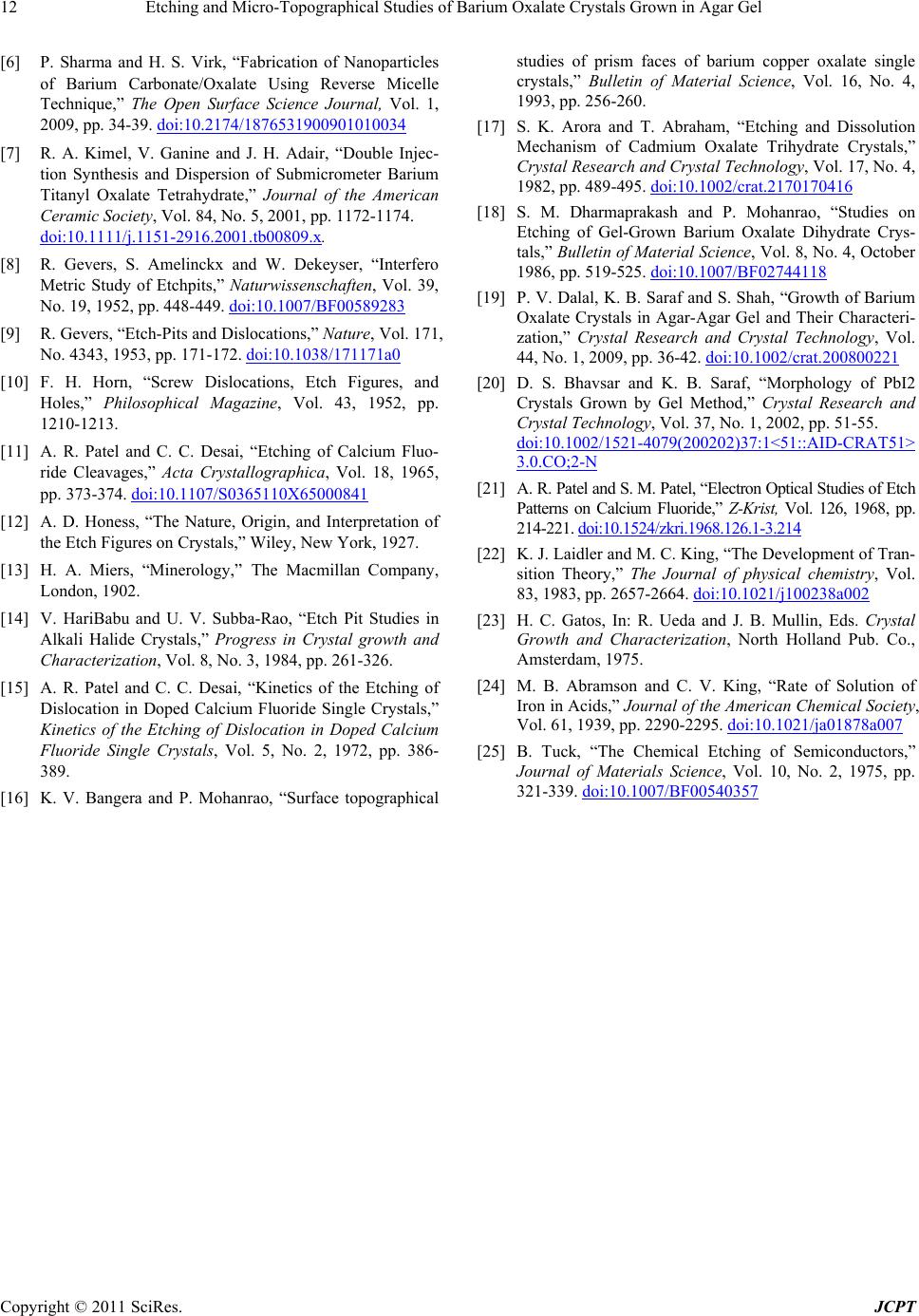
12 Etching and Micro-Topographical Studies of Barium Oxalate Crystals Grown in Agar Gel
[6] P. Sharma and H. S. Virk, “Fabrication of Nanoparticles
of Barium Carbonate/Oxalate Using Reverse Micelle
Technique,” The Open Surface Science Journal, Vol. 1,
2009, pp. 34-39. doi:10.2174/1876531900901010034
[7] R. A. Kimel, V. Ganine and J. H. Adair, “Double Injec-
tion Synthesis and Dispersion of Submicrometer Barium
Titanyl Oxalate Tetrahydrate,” Journal of the American
Ceramic Society, Vol. 84, No. 5, 2001, pp. 1172-1174.
doi:10.1111/j.1151-2916.2001.tb00809.x.
[8] R. Gevers, S. Amelinckx and W. Dekeyser, “Interfero
Metric Study of Etchpits,” Naturwissenschaften, Vol. 39,
No. 19, 1952, pp. 448-449. doi:10.1007/BF00589283
[9] R. Gevers, “Etch-Pits and Dislocations,” Nature, Vol. 171,
No. 4343, 1953, pp. 171-172. doi:10.1038/171171a0
[10] F. H. Horn, “Screw Dislocations, Etch Figures, and
Holes,” Philosophical Magazine, Vol. 43, 1952, pp.
1210-1213.
[11] A. R. Patel and C. C. Desai, “Etching of Calcium Fluo-
ride Cleavages,” Acta Crystallographica, Vol. 18, 1965,
pp. 373-374. doi:10.1107/S0365110X65000841
[12] A. D. Honess, “The Nature, Origin, and Interpretation of
the Etch Figures on Crystals,” Wiley, New York, 1927.
[13] H. A. Miers, “Minerology,” The Macmillan Company,
London, 1902.
[14] V. HariBabu and U. V. Subba-Rao, “Etch Pit Studies in
Alkali Halide Crystals,” Progress in Crystal growth and
Characterization, Vol. 8, No. 3, 1984, pp. 261-326.
[15] A. R. Patel and C. C. Desai, “Kinetics of the Etching of
Dislocation in Doped Calcium Fluoride Single Crystals,”
Kinetics of the Etching of Dislocation in Doped Calcium
Fluoride Single Crystals, Vol. 5, No. 2, 1972, pp. 386-
389.
[16] K. V. Bangera and P. Mohanrao, “Surface topographical
studies of prism faces of barium copper oxalate single
crystals,” Bulletin of Material Science, Vol. 16, No. 4,
1993, pp. 256-260.
[17] S. K. Arora and T. Abraham, “Etching and Dissolution
Mechanism of Cadmium Oxalate Trihydrate Crystals,”
Crystal Research and Crystal Technology, Vol. 17, No. 4,
1982, pp. 489-495. doi:10.1002/crat.2170170416
[18] S. M. Dharmaprakash and P. Mohanrao, “Studies on
Etching of Gel-Grown Barium Oxalate Dihydrate Crys-
tals,” Bulletin of Material Science, Vol. 8, No. 4, October
1986, pp. 519-525. doi:10.1007/BF02744118
[19] P. V. Dalal, K. B. Saraf and S. Shah, “Growth of Barium
Oxalate Crystals in Agar-Agar Gel and Their Characteri-
zation,” Crystal Research and Crystal Technology, Vol.
44, No. 1, 2009, pp. 36-42. doi:10.1002/crat.200800221
[20] D. S. Bhavsar and K. B. Saraf, “Morphology of PbI2
Crystals Grown by Gel Method,” Crystal Research and
Crystal Technology, Vol. 37, No. 1, 2002, pp. 51-55.
doi:10.1002/1521-4079(200202)37:1<51::AID-CRAT51>
3.0.CO;2-N
[21] A. R. Patel an d S. M. Pa te l, “Elec tron Optica l St udies of Etc h
Patterns on Calcium Fluoride,” Z-Krist, Vol. 126, 1968, pp.
214-221. doi:10.1524/zkri.1968.126.1-3.214
[22] K. J. Laidler and M. C. King, “The Development of Tran-
sition Theory,” The Journal of physical chemistry, Vol.
83, 1983, pp. 2657-2664. doi:10.1021/j100238a002
[23] H. C. Gatos, In: R. Ueda and J. B. Mullin, Eds. Crystal
Growth and Characterization, North Holland Pub. Co.,
Amsterdam, 1975.
[24] M. B. Abramson and C. V. King, “Rate of Solution of
Iron in Acids,” Journal of the American Chemical Society,
Vol. 61, 1939, pp. 2290-2295. doi:10.1021/ja01878a007
[25] B. Tuck, “The Chemical Etching of Semiconductors,”
Journal of Materials Science, Vol. 10, No. 2, 1975, pp.
321-339. doi:10.1007/BF00540357
Copyright © 2011 SciRes. JCPT